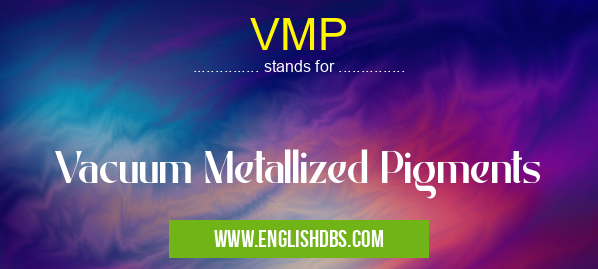What does VMP mean in UNCLASSIFIED
Vacuum Metallized Pigments (VMP) are specialized reflective pigments produced through a vacuum metallization process. These pigments are widely used in various industries to impart a metallic luster and enhance the aesthetic appeal of products.

VMP meaning in Unclassified in Miscellaneous
VMP mostly used in an acronym Unclassified in Category Miscellaneous that means Vacuum Metallized Pigments
Shorthand: VMP,
Full Form: Vacuum Metallized Pigments
For more information of "Vacuum Metallized Pigments", see the section below.
What is Vacuum Metallization?
Vacuum metallization is a technique where a thin layer of metal, typically aluminum or chromium, is deposited onto a substrate material in a vacuum chamber. The substrate can be a variety of materials, such as plastic, glass, ceramic, or metal.
Production of VMP
VMP is produced by vaporizing the metal in a vacuum environment and then depositing it onto the substrate. This process creates a thin, uniform layer of metal that provides a mirror-like finish. The thickness of the metal layer can be controlled to achieve desired levels of reflectivity.
Applications of VMP
VMPs find application in a wide range of industries, including:
- Automotive: Used in automotive paints and trim to enhance appearance
- Cosmetics: Imparts shimmer and glow in makeup products
- Packaging: Provides a metallic finish to packaging materials
- Textiles: Adds metallic effects to fabrics and garments
- Decorative: Used in interior and exterior decor items for a metallic touch
Advantages of VMP
- High Reflectivity: Provides a brilliant metallic luster
- Durability: Resists fading and corrosion
- Versatility: Can be applied to various substrates
- Cost-Effectiveness: More cost-effective than using solid metal components
Essential Questions and Answers on Vacuum Metallized Pigments in "MISCELLANEOUS»UNFILED"
What are Vacuum Metallized Pigments (VMPs)?
VMPs are pigments created by vaporizing metal particles and depositing them onto a substrate, typically a polyester film. This process creates a thin, reflective layer that imparts metallic properties to the substrate.
What are the key characteristics of VMPs?
VMPs exhibit high brilliance, reflectivity, and color saturation. They are resistant to fading, chemicals, and heat, making them suitable for various applications.
What are the advantages of using VMPs over traditional pigments?
VMPs offer superior brilliance, durability, and versatility compared to traditional pigments. They can create a wider range of colors and effects, and are more resistant to environmental factors.
What are the primary applications of VMPs?
VMPs are widely used in cosmetics, automotive, packaging, and home décor industries. They are employed in products such as eyeshadows, car paints, gift wrapping papers, and wallpaper.
Are VMPs safe for use in cosmetics?
Yes, VMPs approved for cosmetic use are generally considered safe. They have been evaluated by regulatory bodies and meet specific purity and toxicity standards.
How should VMPs be stored and handled?
VMPs should be stored in a cool, dry place away from direct sunlight. They are sensitive to moisture and heat, which can affect their performance.
What are the environmental implications of using VMPs?
VMPs can contribute to waste if not disposed of properly. However, they are less environmentally harmful than traditional metal pigments due to their reduced metal content and improved recyclability.
Final Words: Vacuum Metallized Pigments (VMP) are an essential component in various industries, providing a metallic finish to products. Their versatility, durability, and cost-effectiveness make them a preferred choice for enhancing the aesthetic appeal and value of a wide range of applications.
